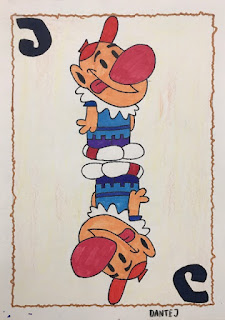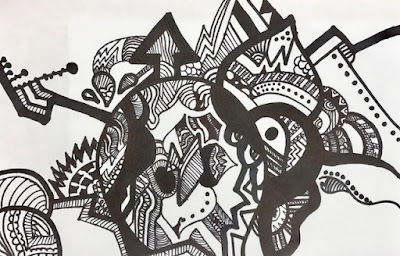Project Home School
- Take a pic of your finished work (must have signature and date visible), and upload to our Google Classroom assignment for today.
- Do not worry if you do not have art supplies. All you need is a pencil, paper, and a bit of imagination for the majority of these projects.
- Students enrolled in multiple art classes must complete different assignments for each class. You are not allowed to submit the same assignment for more than one class.
- Remember, art is good for the soul! Have fun making art!
- Sculpt a bird using playdoh
- Sculpt a unicorn using playdoh
- Create a clay cactus plant using playdoh
- Create a clay fairy door using playdoh
- Sculpt a face using playdoh. You may opt to use an armature as seen in the first video, although it is not mandatory.
- Create a miniature food sculpture of choice from the video below.
- Create a fox sculpture by clicking on the link and following step by step instructions.
- Create a pig sculpture by clicking on the link and following step by step instructions.
- Create a turtle sculpture by clicking on the link for step by step instructions.
Step by step turtle instructions
- Create a dia de los Muertos sugar skull sculpture using playdoh. You must also complete and envision planning sheet for the project. Your skull may either be in black-and-white or you can add some color. You may also opt to use rhinestones or other embellishments if you have them.
- Sculpt a Hamsa Hand. A Hamsa Hand is a palm-shaped amulet popular throughout the Middle East and in the Maghreb and commonly used in jewelry and wall hangings. Depicting the open right hand, an image recognized and used as a sign of protection in many times throughout history, the hamsa is believed by some, predominantly Muslims and Jews, to provide defense against the evil eye. For ideas on patterns, you may do a google search for "Hamsa hand patterns."
- Sculpt a miniature whimsical house out of playdoh.
- Shabti Figure A shabti (also known as shawabti or ushabti) is a funerary figurine of about 5 - 30 centimetres found in many ancient Egyptian tombs. They are commonly made of blue or green glazed Egyptian faience, but can also consist of stone, wood, clay, metal, and glass. The requirements for this assignment are to create a clay shabti and list 3 things you learned from the slideshare.
- Wayne Thiebaud mini cakes/sweet treats (for ceramics students) Create a mini cake, pie, or other sweet treat paying homage to Pop artist, Wayne Thiebaud. The requirements for this project are to create a mini sweet treat based off of your plan, to view the attached slideshare on artist, Wayne Thiebaud and submit 3 things you learned about the artist.
(TLS they mention in the cupcake video is translucent liquid sculpey)
ART I ASSIGNMENTS:
- Find your closest twin in a famous work of art. (assignment mentions submitting photos to "slides", but you will just upload this to our Google Classroom Assignment).
- Create an optical illusion. Divide your square sheet of paper into 8 sections. Starting from the center, begin adding squares that are spaced 1/2 inch apart. Once you've added all the squares, going to the outside edge of your paper, you may begin adding sharpie marker, alternating between black and white.
- Use the web-based program "Canva" to create a magazine cover. Click on the link to access a YouTube tutorial.
- Create “black out poetry.”
2. Gather the interesting words. Have students scan the page looking for words and phrases that jump out at them. They will circle those words lightly in pencil. Remember, we read from top to bottom and left to right, so the words need to be in that order so the reader will understand the poem in the same way the writer wants. It is also helpful to think about the theme you are trying to convey. What do you want the reader to understand or feel after having read your poem?
3. Once students are happy with their poem, they can begin to blackout the page. There is so much flexibility in this step! Students can simply blacken the words with a marker, or they can connect them with color. They can paint or illustrate the page — even use collage.
Or — create an image that fits with the poem. After circling the words, you can sketch a design that fits with the theme or images of the poem. You may opt to add color.
- Choose one of the following contemporary artists to research and provide the following information: an image of one of their works of art, a short critique of the piece (do you like it and why or why not), and at least one thing you learned about them.
- Homemade Scratch Drawings
This was one of my favorite things to do as a kid! And this is a great idea for parents who have a lot of old crayons that are down to stubs. Basically, they just have to apply the crayon heavily so it builds up a waxy layer. Any sharp object can be used to scratch with. I recommend the large sized paperclips as they’re a little more sturdy than the smaller ones. But tacks and very small screwdrivers work, too! The best part is that if they do something they don’t like, they can color over it with black and try again.
- Use the art prompt generator below to give you a prompt to draw. ***Be sure to list on your drawing what the prompt was.
- Shoe still life drawing: Set a shoe in front of you and draw it, paying attention to detail, light, and shadow. This will need to be done in pencil and without color.
- Object Morph: Show one object slowly morphing into another similarly shaped object over a series of 3-5 drawings. See the examples below.
- Gather everyone in your family and have them dress in shades of the same color and take a picture- upload this to our Google Classroom Assignment for January 21st. We call this a monochromatic color scheme. See examples below.
- Make "Fan Art." Take 3 characters real or fictitious and draw them using a comic book style. These should be miniature drawings (we call them "thumbnails") roughly 2"x3". See examples below.
- Draw a 3D Letter of choice using the attached YouTube video's technique
3D Letter Video
- Make a "shadow doodle" by creatively incorporating an object's shadow into a drawing. See example and YouTube videos below.
- A blind contour line drawing is a drawing of the contours of an object that is done without looking at what you’re drawing. You will be drawing your hand. Set a timer for 10 minutes. Pick a point on your non-dominant hand where the eye can begin its slow journey around the contour or edge. Remember, the eye is like a snail, barely crawling as it begins its journey. When the eye begins to move, so should the hand holding the pencil. At no time during the process should you look at your drawing. Try drawing the entire contour of your opposite hand without lifting your pencil from the paper. See the video for further clarification. The importance of this exercise is to train your eye to pay attention to detail.
- Give a shout out to a CMHS teacher that has impacted you by decorating a card, sidewalk (if you have sidewalk chalk), window (if you have paint), etc. Include the teacher’s name and why you are thanking them and make it decorative. You may opt to include a picture or even do this as a comic.
- Draw and shade a ribbon using pencil and paper. For help drawing and shading a ribbon, click on the “ribbon video” link.
- Create a found object value scale. Using at least 9 objects in a range of values, create a value scale. Make sure to arrange the objects in order from brightest white to the darkest black and take a picture to submit. Also include your name on a sheet of paper to receive credit, or you may opt to pose in your picture. See example below.
- Recreate a famous painting at home. Materials needed: random supplies found around the house. Scour the internet for famous paintings. Save your chosen painting to your computer then recreate it at home with supplies found around the house. To receive full credit, you must be the subject in your recreated painting (ie, you MUST appear in the photo taken) and you must send both original and recreated painting to Ms. Ores. Please mention the title of the painting in your email. See images below for examples.
- Create a radially symmetrical design using objects found around the house. The example below uses objects found in nature.
- Make a toilet paper roll sculpture. All you need is an empty toilet paper roll and some imagination. Tools found around the house (a spoon or butter knife) may also be helpful, but not necessary. Use the videos below as guidance. Some find that wetting the toilet paper roll helps it to fold better. Just experiment and send your best attempt. You may opt to paint the sculpture when finished. Sometimes this helps to accentuate the wrinkles.
- Create a found object color wheel using things found around the house. Make sure to write your name on a slip of paper to include in the photo of your work that you send for credit. Your name MUST appear in the photo to receive credit- upload to our Google classroom assignment for January 21st.
- Research a famous artwork while going on a virtual tour across the world. Answer questions using provided handout and also use your drawing skills.
- 100 Drawing prompts. Select from drawing prompts to help you improve your drawing a creative skills.
- Bird's Eye/Bug's Eye View- one point perspective
- Mandala and Tangle doodle coloring pages. Color or create your own mandala!


























































Comments
Post a Comment